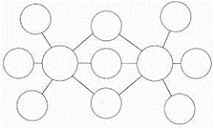Lately, I've spent quite a bit of time in the kitchen. With two three-day weekends in a row, I've had the energy and time it takes to whip up some sweet delights for my family and friends--banana bread and orange loaves of bread sprinkled with tart cranberries. Yummy!
At some point during my baking binge, it occurred to me how much teaching and baking have in common. Perhaps you're thinking, "Well, that's quite a stretch" to which I would answer, "Not at all." Perhaps that's why I savor the time I spend baking as much as the time I spend teaching.
To prove my point, I'm going to take out my imaginary Double Bubble Thinking Map for the purpose of comparing and contrasting. (I interrupt this blog for a short commercial in favor of Thinking Maps. Utilizing Thinking Maps will enable your students to connect an intangible thought process to a tangible map.) In one bubble, I'm going to write "Teaching" and in the other, "Baking". In the center bubbles, I'm going to write their similarities.
Now let's pretend I'm a student and I just finished talking to my partner using a Kagan Mix-Pair-Share exercise. I'm ready to take my information off the map and write about it. Here goes:
Both teaching and baking are alike in a variety of ways. For one thing, they are both rooted in scientific procedures. For instance, best practices in teaching spring forth from brain research that reveal how learning takes place. Science also explains how it's possible for a quickbread to rise sans yeast. A chemical reaction takes place when gas bubbles are released and the acids come in contact with base chemicals. Another similarity teaching and baking have in common is the fact that flexibility and precision can coexist in both. For example, cranberries in orange cranberry bread can be substituted with blueberries. Real eggs can be replaced with flax eggs. In the realm of teaching, children need to be exposed to text in order to learn academic vocabulary and comprehension, but the Common Core Standards provide educators with the flexibility to decide which texts to bring into the classroom. Thirdly, both endeavors require patience. On the surface, it may seem counterintuitive to say that a quick bread requires patience, but it does. You must assemble the ingredients, measure them, and finally mix them. Then you need to let the heat in the oven do its job. When the timer goes off, you need to poke the bread to see if it comes out clean. If not, you need to put the pan back for a few minutes and then test it again. At various points in a lesson, you will need to assemble the materials, measure students' understanding, and tweak the lesson based on what you discover. At the end of the lesson, you may give students an exit ticket to see if they met the learning target. Then you'll make adjustments again. As you can see, teaching and baking have a lot in common.
Both teaching and baking have a lot of moving parts, but eventually, they come together beautifully!
I'm still cooking up irresistible recipes for success in the kitchen and in the classroom!
Lola E. Jollie







No comments:
Post a Comment